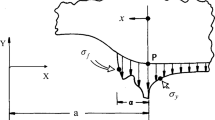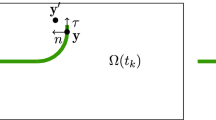Abstract
A probabilistic crack growth model based on a nonlinear damage accumulation criterion is presented. The damage criterion takes cognizance of the effect of the loading sequence, and is an energy-based function. The simulation results are shown to compare favourably with experimental data of four different types of steels and an aluminum alloy. The predicted results are also compared with that of the linear damage theory and, in general, are found to be superior.
Résumé
On présente un modèle probabiliste de croissance d'une fissure, basé sur un critère d'accumulation du dommage non linéaire. Le critère d'endommagement prend en compte l'effet de la séquence de mise en charge, et est une fonction de lénergie. On montre que les résultats d'une simulation soutiennent favorablement la comparaison avec des données expérimentales, dans le cas de quatre aciers différents et d'un alliage d'aluminium. Les résultats prédits sont également comparés avec ceux que fournit la théorie du dommage linéaire et, en général, apparaissent leur être supérieurs.
Similar content being viewed by others
References
A.K.Head, Philosophical Magazine 44 (1953) 925–958.
F.Ellyin and C.O.A.Fakinlede, Engineering Fracture Mechanics 22 (1985) 697–712.
M.A.Miner, ASME Journal of Applied Mechanics 12A (1945) 159–164.
D.Kujawski and F.Ellyin, International Journal of Fatigue 6 (1984) 83–88.
K.Golos and F.Ellyin, Theoretical and Applied Fracture Mechanics 7 (1987) 169–176.
K.P.Oh, ASME Journal of Engineering Materials and Technology 100 (1984) 170–174.
Z.Hashin and C.Laird, Fatigue of Engineering Materials and Structures 2 (1980) 147–160.
J.W.Hutchinson, ASME Journal of Applied Mechanics 50 (1983) 1042–1051.
F.Ellyin, Engineering Fracture Mechanics 25 (1986) 463–473.
F.Ellyin and D.Kujawski ASME Journal of Pressure Vessel Technology 106 (1984) 342–347.
F.Ellyin, ASME Journal of Engineering Materials and Technology 107 (1985) 119–125.
J. Morrow, in Internal Friction, Damping and Cyclic Plasticity, ASTM STP 378, American Society for Testing and Materials (1965) 45–87.
IMSL International Mathematical and Statistical Library, Houston, TX (1982).
F.Ellyin and H.P.Li, ASME Journal of Pressure Vessel Technology 10 (1984) 255–260.
I.M.Barsom, ASME Journal of Engineering for Industry 93 (1971) 1190–1196.
A. Saxena and S.J. Hudak, in Fracture Mechanics, ASTM STP 677 (1971) 215–232.
N.E. Dowling in Cyclic Stress-Strain and Plastic Deformation Aspects of Fatigue Crack Growth, ASTM STP 637 (1977) 97–121.
Author information
Authors and Affiliations
Rights and permissions
About this article
Cite this article
Ellyin, F., Fakinlede, C.O.A. Probabilistic crack growth by nonlinear damage accumulation. Int J Fract 36, 137–149 (1988). https://doi.org/10.1007/BF00017792
Received:
Accepted:
Issue Date:
DOI: https://doi.org/10.1007/BF00017792




